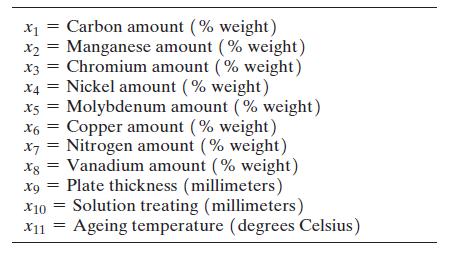Yield strength of steel alloy. Industrial engineers at the University of Florida used regression modeling as a
Question:
Yield strength of steel alloy. Industrial engineers at the University of Florida used regression modeling as a tool to reduce the time and cost associated with developing new metallic alloys (Modelling and Simulation in Materials Science and Engineering, Vol. 13, 2005). To illustrate, the engineers build a regression model for the tensile yield strength (y) of a new steel alloy. The potential important predictors of yield strength are listed in the following table.
a. The engineers used stepwise regression to search for a parsimonious set of predictor variables. Do you agree with this decision? Explain.
b. The stepwise regression selected the following independent variables: x1 = Carbon, x2 = Manganese, x3 = Chromium, x5 = Molybdenum, x6 = Copper, x8 = Vanadium, x9 = Plate thickness, x10 = Solution treating, and x11 = Ageing temperature. On the basis of this information, determine the total number of first-order models that were fit in the stepwise routine.
c. Refer to part
b. All the variables listed there were statistically significant in the stepwise model, with R2 = .94. Consequently, the engineers used the estimated stepwise model to predict yield strength. Do you agree with this decision? Explain.
Step by Step Answer:

Statistics Plus New Mylab Statistics With Pearson Etext Access Card Package
ISBN: 978-0134090436
13th Edition
Authors: James Mcclave ,Terry Sincich






